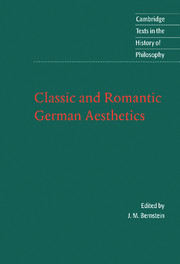Book contents
- Frontmatter
- Contents
- Introduction
- Chronology
- Further reading
- Note on the texts
- Aesthetica in nuce: A Rhapsody in Cabbalistic Prose (1762)
- Laocoön: An Essay on the Limits of Painting and Poetry (1766)
- From ‘On the Artistic Imitation of the Beautiful’ (1788)
- ‘Kallias or Concerning Beauty : Letters to Gottfried Körner’ (1793)
- ‘Oldest Programme for a System of German Idealism’ (1796)
- ‘Letter to Hegel, 26 January 1795’
- ‘Being Judgement Possibility’ (1795)
- ‘The Significance of Tragedy’ (1802)
- ‘Remarks on Oedipus’ (1803)
- From Miscellaneous Remarks (1797)
- ‘Monologue’
- ‘Dialogues’ (1798)
- ‘On Goethe’ (1798)
- ‘Studies in the Visual Arts’ (1799)
- From ‘Critical Fragments’ (1797)
- From ‘Athenaeum Fragments’ (1798)
- From ‘Ideas’ (1800)
- ‘On Goethe's Meister’ (1798)
- ‘Letter About the Novel’ (1799)
- ‘On Incomprehensibility’ (1800)
- Index
- Cambridge texts in the history of philosophy
‘On Goethe’ (1798)
Published online by Cambridge University Press: 05 June 2012
- Frontmatter
- Contents
- Introduction
- Chronology
- Further reading
- Note on the texts
- Aesthetica in nuce: A Rhapsody in Cabbalistic Prose (1762)
- Laocoön: An Essay on the Limits of Painting and Poetry (1766)
- From ‘On the Artistic Imitation of the Beautiful’ (1788)
- ‘Kallias or Concerning Beauty : Letters to Gottfried Körner’ (1793)
- ‘Oldest Programme for a System of German Idealism’ (1796)
- ‘Letter to Hegel, 26 January 1795’
- ‘Being Judgement Possibility’ (1795)
- ‘The Significance of Tragedy’ (1802)
- ‘Remarks on Oedipus’ (1803)
- From Miscellaneous Remarks (1797)
- ‘Monologue’
- ‘Dialogues’ (1798)
- ‘On Goethe’ (1798)
- ‘Studies in the Visual Arts’ (1799)
- From ‘Critical Fragments’ (1797)
- From ‘Athenaeum Fragments’ (1798)
- From ‘Ideas’ (1800)
- ‘On Goethe's Meister’ (1798)
- ‘Letter About the Novel’ (1799)
- ‘On Incomprehensibility’ (1800)
- Index
- Cambridge texts in the history of philosophy
Summary
445. Goethe is a practical poet through and through. He is in his works – what the English are in their wares – utterly simple, neat, convenient and durable. He has done for German literature what Wedgwood did for English art. Like the Englishman, he has a natural business sense and a refined taste acquired by good sense. Both are wholly compatible with each other, and are closely related, in the chemical sense. His studies in physics make it quite clear that he is much more inclined to complete something slight, and give it elegance and high finish, than tackle an entire world, or take on something which one can be certain from the start cannot be carried out perfectly, will surely remain awkward, and resists the high polish of mastery. Even in this field he will choose a romantic subject, or something similarly intricate. His observations on light and on the metamorphoses of plants and insects both confirm and demonstrate most convincingly that the perfect style for instruction is also part of the artist's range. There is a sense in which we might also, and rightly, declare that Goethe is the foremost physicist of his time, and has in fact marked an era in physics. It is not a question of the extent of his knowledge, nor would we claim that discoveries determine the stature of a natural scientist. It is rather a question of whether the scientist observes Nature as an artist observes the ancient world – for Nature is something different from living Antiquity.
- Type
- Chapter
- Information
- Classic and Romantic German Aesthetics , pp. 227 - 234Publisher: Cambridge University PressPrint publication year: 2002

